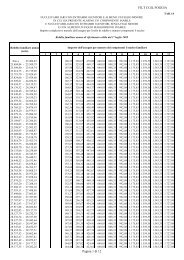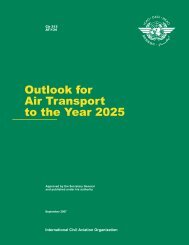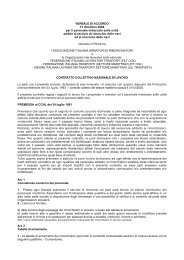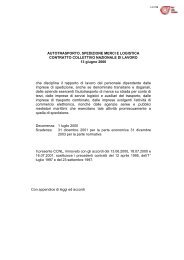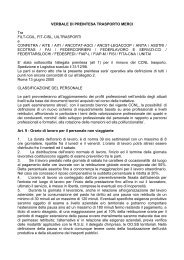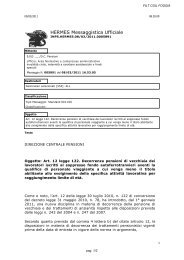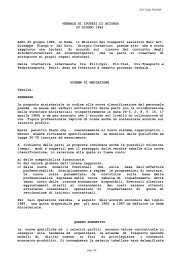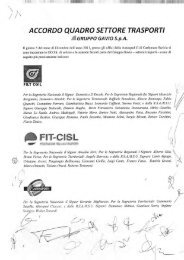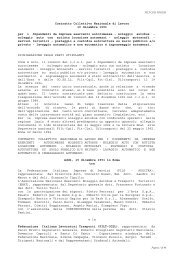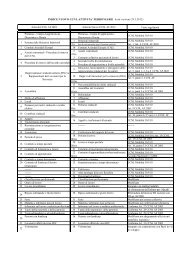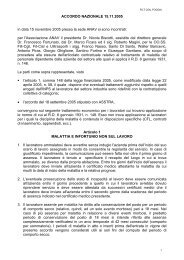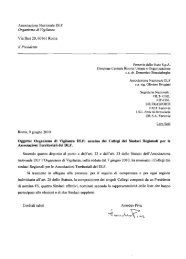Outlook for Air Transport to the Year 2015 - FILT CGIL Foggia
Outlook for Air Transport to the Year 2015 - FILT CGIL Foggia
Outlook for Air Transport to the Year 2015 - FILT CGIL Foggia
Create successful ePaper yourself
Turn your PDF publications into a flip-book with our unique Google optimized e-Paper software.
Chapter 6. Forecasts of <strong>Air</strong>craft Movements <strong>to</strong> <strong>the</strong> <strong>Year</strong> <strong>2015</strong> 43200100<strong>Air</strong>craft size(left-hand scale)15075<strong>Air</strong>craft size (seats)100Load fac<strong>to</strong>r(right-hand scale)50Load fac<strong>to</strong>r (%)502501960 63 66 69 72 75 78 81 84 87 90 93 96 99 2002Source: ICAO Reporting Form A-1.Note: Excluding all-freight operations.Excluding <strong>the</strong> CIS.Figure 6-1. Average aircraft size and load fac<strong>to</strong>r — World (1960–2002)(Passenger aircraft on scheduled services)0air services within <strong>the</strong> European Union. The evolution of competitive strategies and market structures hascontinued since <strong>the</strong>n. Adequate frequency and convenient interline and on-line connections, as well as low price,have become important competitive <strong>to</strong>ols. A more liberal regula<strong>to</strong>ry environment has also emerged gradually ino<strong>the</strong>r domestic markets and in international markets. The consequent increased priority given <strong>to</strong> frequency anddirect service has tended <strong>to</strong> increase <strong>the</strong> number of aircraft movements required <strong>to</strong> satisfy a given level of demand.7. The second fac<strong>to</strong>r is <strong>the</strong> arrival of new, mid-size, high-technology aircraft. The 1970s saw B-747, DC-10and L-1011 aircraft absorbed in<strong>to</strong> airline fleets. These aircraft had favourable range and unit cost characteristicsand were at <strong>the</strong> <strong>to</strong>p end of <strong>the</strong> size spectrum. In <strong>the</strong> 1980s, <strong>the</strong> airlines started <strong>to</strong> introduce mid-size aircraft suchas <strong>the</strong> B-757, B-767, MD-80 and A-310. This trend continued well in<strong>to</strong> <strong>the</strong> 1990s, and <strong>the</strong> airlines witnessed <strong>the</strong>introduction of additional mid-size aircraft such as <strong>the</strong> B-777, A-330 and A-340 in<strong>to</strong> <strong>the</strong>ir fleets. Consequently,fleet replacement and expansion led <strong>to</strong> a modest decline in <strong>the</strong> average aircraft size during <strong>the</strong> late 1990s.8. Recent trends have shown that <strong>the</strong>re has been a gradual deployment of mid-size <strong>to</strong> smaller aircraft onalmost all route groups as <strong>the</strong> need <strong>for</strong> more direct services has become a priority <strong>for</strong> travellers. Regula<strong>to</strong>rydevelopments and <strong>the</strong> characteristics of <strong>the</strong>se new aircraft types may have also been prevailing fac<strong>to</strong>rs <strong>for</strong> <strong>the</strong>irintroduction. This change has resulted in a proliferation of services aimed at cost-cutting measures by reducingflight time and <strong>the</strong> distance flown, especially on longer routes linking two regions. Route groups such as NorthAtlantic and Transpacific are <strong>the</strong> prime examples where such aircraft types have increasingly been introduced.





